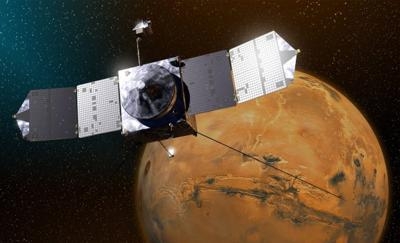Thu, Sep 24, 2015
Entered Orbit September 21, 2014
NASA’s Mars Atmosphere and Volatile EvolutioN (MAVEN) spacecraft has been in orbit around Mars for one Earth year. MAVEN was launched to Mars on Nov. 18, 2013 from Cape Canaveral Air Force Station in Florida and successfully entered Mars’ orbit on Sept. 21, 2014.

“The success of the mission so far is a direct result of the incredibly hard work of everybody who is working and has worked on MAVEN. This one year at Mars reflects the tremendous efforts over the preceding dozen years,” said Bruce Jakosky, MAVEN’s principal investigator from the University of Colorado’s Laboratory for Atmospheric and Space Physics in Boulder.
Some of the highlights of the first action-packed year include:
- Performing the orbit insertion maneuver
- Surviving the encounter with Comet Siding Spring
- Commissioning the spacecraft
- Carrying out ten months of observations during MAVEN’s primary mission
- Carrying out four deep-dip campaigns
“The team has done a fantastic job of adapting to spacecraft operations in the Martian environment,” said Richard Burns, MAVEN project manager at NASA’s Goddard Space Flight Center in Greenbelt, Maryland. “All systems on MAVEN remain in excellent working condition.”
MAVEN began its primary science mission on Nov. 16, 2014, and is the first spacecraft dedicated to understanding Mars’ upper atmosphere. The goal of the mission is to determine the role that loss of atmospheric gas to space played in changing the Martian climate through time. MAVEN is studying the entire region from the top of the upper atmosphere all the way down to the lower atmosphere so that the connections between these regions can be understood.
“We still have two months to go in our primary mission, and then we begin our extended mission,” Jakosky said. “We’re obtaining an incredibly rich data set that is on track to answer the questions we originally posed for MAVEN and that will serve the planetary science community for a long time to come.”
(Image provided by NASA)
More News
Pilot Also Reported That Due To A Fuel Leak, The Auxiliary Fuel Tanks Were Not Used On June 4, 2025, at 13:41 eastern daylight time, a Piper PA-23, N2109P, was substantially damage>[...]
Have A Story That NEEDS To Be Featured On Aero-News? Here’s How To Submit A Story To Our Team Some of the greatest new stories ANN has ever covered have been submitted by our>[...]
From 2023 (YouTube Edition): Reflections on War’s Collective Lessons and Cyclical Nature The exigencies of war ought be colorblind. Inane social-constructs the likes of racis>[...]
Aero Linx: Colorado Pilots Association (CPA) Colorado Pilots Association was incorporated as a Colorado Nonprofit Corporation in 1972. It is a statewide organization with over 700 >[...]
High Speed Taxiway A long radius taxiway designed and provided with lighting or marking to define the path of aircraft, traveling at high speed (up to 60 knots), from the runway ce>[...]
 NTSB Prelim: Piper PA-23
NTSB Prelim: Piper PA-23 ANN FAQ: Submit a News Story!
ANN FAQ: Submit a News Story! Classic Aero-TV: One Mans Vietnam
Classic Aero-TV: One Mans Vietnam ANN's Daily Aero-Linx (07.03.25)
ANN's Daily Aero-Linx (07.03.25) ANN's Daily Aero-Term (07.03.25): High Speed Taxiway
ANN's Daily Aero-Term (07.03.25): High Speed Taxiway



